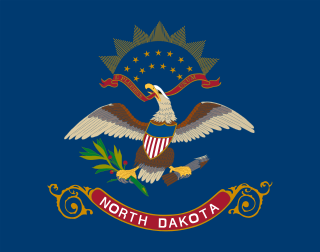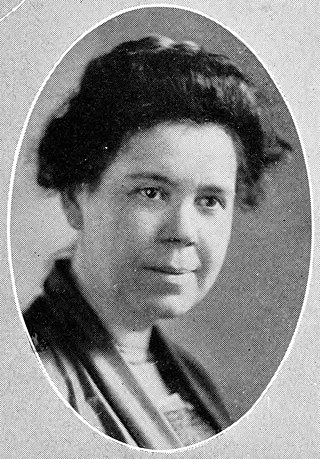
North Dakota is a U.S. state in the Upper Midwest, named after the indigenous Dakota Sioux. It is bordered by the Canadian provinces of Saskatchewan and Manitoba to the north and by the U.S. states of Minnesota to the east, South Dakota to the south, and Montana to the west. North Dakota is part of the Great Plains region, characterized by broad prairies, steppe, temperate savanna, badlands, and farmland. It is believed to host the geographic center of North America, Rugby, and is home to what was once the tallest artificial structure in the Western Hemisphere, the KVLY-TV mast.

The Great Plains, sometimes simply "the Plains", is a broad expanse of flatland in North America. It is located just to the east of the Rocky Mountains, much of it covered in prairie, steppe, and grassland. It is the western part of the Interior Plains, which also include the mixed grass prairie, the tallgrass prairie between the Great Lakes and Appalachian Plateau, and the Taiga Plains and Boreal Plains ecozones in Northern Canada. Great Plains or Western Plains is also used to describe the ecoregion of the Great Plains, or alternatively the western portion of the Great Plains.

Fargo is a city in and the county seat of Cass County, North Dakota, United States. According to the 2020 census, its population was 125,990, making it the most populous city in the state and the 219th-most populous city in the United States. Fargo, along with its twin city of Moorhead, Minnesota, and the adjacent cities of West Fargo, North Dakota and Dilworth, Minnesota, form the core of the Fargo–Moorhead, ND-MN Metropolitan Statistical Area (MSA). The MSA had a population of 248,591 in 2020.
David B. Danbom is a historian, author, and was a professor of agricultural history at North Dakota State University, for more than forty years. Danbom spent nine years on the Fargo Historic Preservation Commission. Danbom also served as president of the Agricultural History Society.

Clay Straus Jenkinson is an American humanities scholar, author and educator. He is currently the director of The Dakota Institute, where he co-hosts public radio's The Thomas Jefferson Hour, and creates documentary films, symposia, and literary projects. He lectures at Dickinson State University and Bismarck State College.

North Dakota was first settled by Native Americans several thousand years ago. The first Europeans explored the area in the 18th century establishing some limited trade with the natives.

Omemee is a ghost town in Bottineau County in the U.S. state of North Dakota. It was a railroad hub in the early 1910s, located at the junction of two major railroads, the Soo Line Railroad and the Great Northern Railway. Incorporated as a city in 1902, Omemee has been abandoned since 2003.

North Dakota's climate is typical of a continental climate with cold winters and warm-hot summers. The state's location in the Upper Midwest allows it to experience some of the widest variety of weather in the United States, and each of the four seasons has its own distinct characteristics. The eastern half of the state has a humid continental climate with warm to hot, somewhat humid summers and cold, windy winters, while the western half has a semi-arid climate with less precipitation and less humidity but similar temperature profiles. The areas east of the Missouri River get slightly colder winters, while those west of the stream get higher summer daytime temperatures. In general, the diurnal temperature difference is prone to be more significant in the west due to higher elevation and less humidity.

Cecil Township is a civil township in Bottineau County in the U.S. state of North Dakota. As of the 2000 census, its population was 28.
Aagot Raaen was an American author and educator.
Brandenburg Township is a civil township located in Richland County, North Dakota, United States. Its population during the 2010 Census was 102, and grew to 133 in the 2020 Census.
The Northern Great Plains History Conference is an annual conference of history professors, graduate students, historical society experts, and other scholars interested in the history of the Great Plains states of the American Midwest. The Conference features scholarly papers by academics and advanced students on a variety of topics, especially in social history and military history, as well as regional topics regarding the Great Plains.

The following works deal with the cultural, political, economic, military, biographical and geologic history of pre-territorial South Dakota, the southern part of Dakota Territory and the State of South Dakota.
The following is a timeline of the history of the city of Fargo, North Dakota, USA.

Douglas James Burgum is an American businessman, investor, philanthropist, and politician serving since 2016 as the 33rd governor of North Dakota. He is among the wealthiest governors in the U.S., with an estimated net worth of $1.1 billion. A member of the Republican Party, Burgum is a candidate in the 2024 United States presidential election.

The 1924 North Dakota gubernatorial election was held on November 4, 1924.

Emma F. Bates was an educator and politician from North Dakota. She served as the fifth North Dakota Superintendent of Public Instruction from 1895 to 1896.

Minnie Jean Nielson was an American educator and literacy activist from North Dakota. She served as the eleventh North Dakota Superintendent of Public Instruction from 1919 to 1926.













